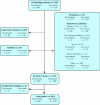How does direct-to-consumer advertising (DTCA) affect prescribing? A survey in primary care environments with and without legal DTCA
- PMID: 12952801
- PMCID: PMC183290
How does direct-to-consumer advertising (DTCA) affect prescribing? A survey in primary care environments with and without legal DTCA
Abstract
Background: Direct-to-consumer advertising (DTCA) of prescription drugs has increased rapidly in the United States during the last decade, yet little is known about its effects on prescribing decisions in primary care. We compared prescribing decisions in a US setting with legal DTCA and a Canadian setting where DTCA of prescription drugs is illegal, but some cross-border exposure occurs.
Methods: We recruited primary care physicians working in Sacramento, California, and Vancouver, British Columbia, and their group practice partners to participate in the study. On pre- selected days, patients aged 18 years or more completed a questionnaire before seeing their physician. We asked these patients' physicians to complete a brief questionnaire immediately following the selected patient visit. By pairing individual patient and physician responses, we determined how many patients had been exposed to some form of DTCA, the frequency of patients' requests for prescriptions for advertised medicines and the frequency of prescriptions that were stimulated by the patients' requests. We measured physicians' confidence in treatment choice for each new prescription by asking them whether they would prescribe this drug to a patient with the same condition.
Results: Seventy-eight physicians (Sacramento n = 38, Vancouver n = 40) and 1431 adult patients (Sacramento n = 683, Vancouver n = 748), or 61% of patients who consulted participating physicians on pre-set days, participated in the survey. Exposure to DTCA was higher in Sacramento, although 87.4% of Vancouver patients had seen prescription drug advertisements. Of the Sacramento patients, 7.2% requested advertised drugs as opposed to 3.3% in Vancouver (odds ratio [OR] 2.2, 95% confidence interval [CI] 1.2-4.1). Patients with higher self- reported exposure to advertising, conditions that were potentially treatable by advertised drugs, and/or greater reliance on advertising requested more advertised medicines. Physicians fulfilled most requests for DTCA drugs (for 72% of patients in Vancouver and 78% in Sacramento); this difference was not statistically significant. Patients who requested DTCA drugs were much more likely to receive 1 or more new prescriptions (for requested drugs or alternatives) than those who did not request DTCA drugs (OR 16.9, 95% CI 7.5-38.2). Physicians judged 50.0% of new prescriptions for requested DTCA drugs to be only "possible" or "unlikely" choices for other similar patients, as compared with 12.4% of new prescriptions not requested by patients (p < 0.001).
Interpretation: Our results suggest that more advertising leads to more requests for advertised medicines, and more prescriptions. If DTCA opens a conversation between patients and physicians, that conversation is highly likely to end with a prescription, often despite physician ambivalence about treatment choice.
Figures


Comment in
-
Direct-to-consumer advertising.CMAJ. 2004 Mar 2;170(5):768-70; author reply 770-1. doi: 10.1503/cmaj.1031565. CMAJ. 2004. PMID: 14993155 Free PMC article. No abstract available.
-
Direct-to-consumer advertising.CMAJ. 2004 Mar 2;170(5):768 ,770; author reply 770-1. doi: 10.1503/cmaj.1031798. CMAJ. 2004. PMID: 14993157 Free PMC article. No abstract available.
References
-
- Rosenthal MB, Berndt ER, Donohue JM, Frank RG, Epstein AM. Promotion of prescription drugs to consumers. N Engl J Med 2002;346(7):498-505. - PubMed
-
- United States General Accounting Office. FDA oversight of direct-to-consumer advertising has limitations. Report to congressional requesters. Report no GAO-03-177. 2000 Oct. Available: http://rxpolicy.com/studies/gao-dtc-adv.pdf (accessed 2003 July 30).
-
- Watson R. EC moves towards “direct to consumer” advertising. BMJ 2001;323:184.
-
- Therapeutic Products Programme. Direct-to-consumer advertising of prescription drugs. Discussion document. Ottawa; Health Canada; 1999.
Publication types
MeSH terms
LinkOut - more resources
Full Text Sources
